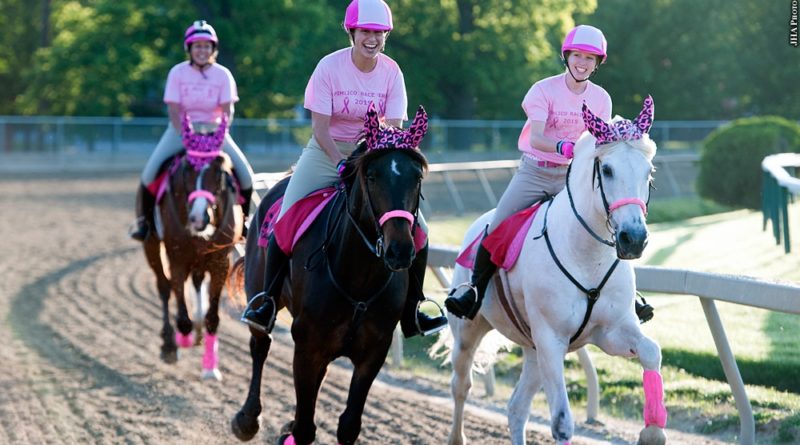Two weeks after the 144th running of the Preakness Stakes — the middle jewel of horse racing’s Triple Crown — Pimlico Race Course will host a fundraiser that will give horse enthusiasts of all ages the chance to walk, trot, canter or gallop on the historic race course.
The Maryland Jockey Club, the company that operates Pimlico, is hosting the fourth annual Canter for the Cause June 2. The event is a fundraiser for the Thoroughbred Aftercare Alliance, a Kentucky-based nonprofit that accredits about 75 thoroughbred aftercare organizations in North America, including six in Maryland.
Georganne Hale, the Maryland Jockey Club’s vice president of racing development, came up with the idea four years ago after realizing the allure Pimlico’s storied track could have for some riders who might watch races but never get to ride around the 9.5 furlongs (1 3/16th miles) of dirt track.
“I run into people every day that ride and they all just think it would be so cool and so neat to ride on the race track,” said Hale, who is in her 37th year with the Maryland Jockey Club. “A lot of them have trail horses, they just ride in their backyards. So I thought, ‘You know, if my bosses were game enough to let me do this, I think it would be fun to let people pay to ride on the track at Pimlico where the Preakness runs.'”
The track has seen some dramatic races in its 149-year history: the match race between Seabiscuit and War Admiral in 1938, the comeback victory by the legendary Secretariat on his way to the first Triple Crown win in a quarter century in 1973, or more recent wins by Triple Crown winners American Pharoah in 2015 and Justify last year.
The inaugural event in 2016 “went off big,” Hale said, drawing about 400 participants to the course. Other years the total has been closer to 300, she said, and around the same number of people have registered for this year’s event.
Potential participants may be further encouraged by the possibility that aging Pimlico’s future is clouded and the Preakness might move to Laurel Park.
Participants pay $50 to register. They are broken into four groups based on their riding ability and can choose to walk, trot, canter or gallop. Riders are sent out in batches of 10 to 15 at a time. They get about 20 minutes to walk through the starting gate, take laps around the course and then finish with a photo in the winner’s circle where Preakness winners through the decades have posed for photos with the iconic black-eyed Susan flower blanket draped over their neck.
Hale said visitors as young as 3 and as old as 80 have participated during the event’s history. In past years, Baltimore Police has sent members of its Mounted Division to the event.
“Everybody loves it, and you see them, they have big smiles on their faces as they’re riding their horses around,” Hale said. “I would see neighbors in the neighborhood, they would be standing watching everybody with their kids on Sunday after church.”
The relationship between the Thoroughbred Aftercare Alliance, Maryland Jockey Club and Stronach Group — the parent company of the Jockey Club — began when the TAA was founded in 2013, according to TAA operations consultant Stacy Rogers, and the goal is simple.
“We want to do better things for our horses and for them after racing,” Rogers said, “to make sure that they get good jobs and have a happy landing after retirement.”
About 8,000 horses have benefited from TAA-accredited organizers, Rogers said. Some of the funds raised by events like Canter for the Cause will go toward continuing to accredit more organizations while about 75 percent of the money raised will go to the organizations directly. About $10,000 was raised by the event last year.
Rogers credited Hale and others in the Maryland equestrian community for raising awareness about thoroughbreds to show the “versatility” of a horse that some might think is only for racing but can serve many functions like hunting or therapeutic riding after they retire.
“It’s a very horsey community,” Rogers said. “The horses in Maryland can run one week and go foxhunting the next week. It’s a very sensitive, high-functioning horse that is used to being around people its entire life, so it adapts very well to most things you ask it to do.
“These kinds of initiatives are really beneficial to think outside the box and to get the community involved at the racetrack and the racetrack involved with the community.”
Photo Credit: JHA Photo
Issue 254: May 2019

